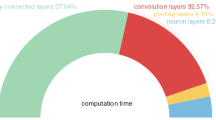Abstract
Deep Learning (DL) model building is a tedious and taxing process. The number of prerequisites is high and a lot of time is invested. Hence, there is a scope of Automation. Code to build DL models follows a standard structure, broadly classified into four categories (Imports, Data Input, Model Creation, and Evaluation). The work in this paper proposes to automate this core structure and build a Graphical User Interface (GUI) based tool/platform called “Auto-DL” which, on defining the task and training data, generates code in python for the specified deep learning model. The paper then discusses the platform capabilities and evaluates it and the generated code against various quantitative and qualitative parameters.
Access this chapter
Tax calculation will be finalised at checkout
Purchases are for personal use only
Similar content being viewed by others
References
Predictive Model Markup Language (PMML): A XML based standard for predictive model generation, Wikipedia, 10 Oct 2005. https://en.wikipedia.org/wiki/Predictive_Model_Markup_Language. Accessed Jan 2021
AutoHTML: Parse Images to generate HTML Pages, Github, 06 Oct 2019. https://github.com/ADI10HERO/AutoHTML. Accessed Jan 2021
Balaji, A., Allen, A.: Benchmarking automatic machine learning frameworks arXiv:1808.06492 [cs.LG] (2018)
AutoML Software/Tools in 2021: In-depth Guide. https://research.aimultiple.com/auto-ml-software. Accessed Apr 2021
Google Cloud AutoML. https://cloud.google.com/automl. Accessed Apr 2021
The AI Talent Shortage Isn’t Over Yet. https://deloitte.wsj.com/cmo/2020/10/16/the-ai-talent-shortage-isnt-over-yet/. Accessed Apr 2021
A majority of data scientists lack competency in advanced machine learning areas and techniques. https://businessoverbroadway.com/2018/02/18/a-majority-of-data-scientists-lack-competency-in-advanced-machine-learning-areas-and-techniques. Accessed Apr 2021
AutoAI with IBM Watson Studio. https://www.ibm.com/in-en/cloud/watson-studio/autoai. Accessed Apr 2021
Flash-ML - drag & drop machine learning models w/ PyTorch flexibility. https://www.producthunt.com/posts/flashml. Accessed May 2021
H2O Driverless AI. https://www.h2o.ai/products/h2o-driverless-ai/. Accessed May 2021
DataRobot. https://www.datarobot.com/. Accessed May 2021
MakeML - create object detection and segmentation ML models without code. https://makeml.app/. Accessed May 2021
RapidMiner. https://rapidminer.com. Accessed May 2021
TPOT. http://automl.info/tpot. Accessed May 2021
Measuring Software Maintainability. https://quandarypeak.com/2015/02/measuring-software-maintainability/. Accessed May 2021
Pylint: python code static checker. https://pypi.org/project/pylint/. Accessed May 2021
Pylint Static Code Analysis—Github Action to fail below a score threshold. https://medium.com/analytics-vidhya/pylint-static-code-analysis-github-action-to-fail-below-a-score-threshold-58a124aafaa0. Accessed May 2021
Halstead Metrics. https://radon.readthedocs.io/en/latest/intro.html#halstead-metrics. Accessed May 2021
siege.js. https://www.npmjs.com/package/siege. Accessed May 2021
Amazon EC2 Instance Types. https://aws.amazon.com/ec2/instance-types/. Accessed May 2021
Cats vs Dogs Dataset. https://drive.google.com/file/d/16R6_yzSUHQ3BZezOBzouXBYJO_VcYW8F/view. Accessed July 2021
THE MNIST DATABASE of handwritten digits. Yann LeCun, Courant Institute, NYU Corinna Cortes, Google Labs, New York Christopher J.C. Burges, Microsoft Research, Redmond. http://yann.lecun.com/exdb/mnist/
(CIFAR-10) Learning Multiple Layers of Features from Tiny Images, Alex Krizhevsky (2009). https://www.cs.toronto.edu/~kriz/learning-features-2009-TR.pdf
Understanding Siege’s Results. https://www.digitalocean.com/community/tutorials/how-to-benchmark-a-website-with-firefox-siege-and-sproxy-on-ubuntu-16-04. Accessed May 2021
Radon. https://radon.readthedocs.io/en/latest/. Accessed May 2021
Author information
Authors and Affiliations
Corresponding author
Editor information
Editors and Affiliations
Rights and permissions
Copyright information
© 2021 Springer Nature Singapore Pte Ltd.
About this paper
Cite this paper
Srivastava, A., Shinde, T., Joshi, R., Ansari, S.A., Giri, N. (2021). Auto-DL: A Platform to Generate Deep Learning Models. In: Mohamed, A., Yap, B.W., Zain, J.M., Berry, M.W. (eds) Soft Computing in Data Science. SCDS 2021. Communications in Computer and Information Science, vol 1489. Springer, Singapore. https://doi.org/10.1007/978-981-16-7334-4_7
Download citation
DOI: https://doi.org/10.1007/978-981-16-7334-4_7
Published:
Publisher Name: Springer, Singapore
Print ISBN: 978-981-16-7333-7
Online ISBN: 978-981-16-7334-4
eBook Packages: Computer ScienceComputer Science (R0)




